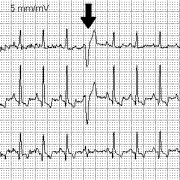Spotlight on antithrombotics in small animal veterinary practice
‘In the Spotlight’ features bring together collections of published papers on topics of interest and importance to the veterinary professions.
If you would like to suggest a paper for inclusion in one of our published Spotlight features, or a topic for a future Spotlight feature, please email library@rcvsknowledge.org
Antithrombotics in small animal veterinary practice
Published June 2019 | Updated 23 September 2022
Antithrombotics are medications that reduce the formation of blood clots. There are two classes of antithrombotics: anticoagulants and antiplatelet agents. In human medicine both anticoagulants (such as warfarin) and antiplatelet agents (such as low dose aspirin and clopidogrel) are widely used to reduce the risk of stroke, myocardial infarction, deep venous thrombosis (DVT) and pulmonary embolism. In human medicine there are evidence-based guidelines to support the use of these medications based on large scale randomized controlled studies.
The diseases associated with thrombosis in dogs and cats are different, not only from those seen in human medicine, but also from each other. None the less both species can be at risk for developing coagulation abnormalities leading to both venous and arterial thrombosis.
A recent special issue of the Journal of Veterinary Emergency and Critical Care includes a series of articles which make up the American College of Veterinary Emergency and Critical Care (ACVECC), Consensus on the Rational Use of Antithrombotics in Veterinary Critical Care (CURATIVE) guidelines.
The guidelines were developed by a panel of experts who systematically reviewed the literature under five headings:
1. Defining populations at risk
2. Defining rational therapeutic usage
3. Defining antithrombotic protocols
4. Refining and monitoring antithrombotic therapies
5. Discontinuation of anticoagulant therapy in small animals
The working groups reviewed published studies, covering the 5 domains, using standardised worksheets, and generated 59 statements and 83 recommendations. These were refined through three rounds of Delphi surveys and presented and discussed at both the European Veterinary Emergency and Critical Care (EVECC) Congress and the International Veterinary Emergency and Critical Care Symposium (IVECCS) in 2018.
CURATIVE Guidelines
Goggs, R. et al. (2019) American College of Veterinary Emergency and Critical Care (ACVECC) Consensus on the Rational Use of Antithrombotics in Veterinary Critical Care (CURATIVE) guidelines: Small animal. Journal of Veterinary Emergency and Critical Care 29 (1), pp. 12-36.
[This article can be accessed via RCVS Knowledge Library Membership, click here]
This paper provides details of the methodology and a summary of the statements and recommendations divided under each of the 5 domains as well as the levels of evidence and degree of agreement for each of the statements / recommendations noting areas where evidence is lacking. Where there was insufficient evidence to provide specific recommendations there are suggestions based on the expertise of the contributors. The guidelines also include the full list of references for the papers that were reviewed
The guidelines are supported by five papers, each summarising the recommendations and literature relating to one of the domains. It should be noted that the guidelines and case scenarios concentrate on reducing the risk of thrombosis and use of antithrombotics and do not include mention of thrombolytic therapies.
Although the guidelines state that they are intended for use in “Academic and referral veterinary medical centers”, they are also supported by a paper uses clinical scenarios that demonstrate how the CURATIVE guidelines could be applied in practice.
Published 23 September 2022
Domain 6 – Defining rational use of thrombolytics
Other literature
- Fox, P.R. et al. (2018) International collaborative study to assess cardiovascular risk and evaluate long‐term health in cats with preclinical hypertrophic cardiomyopathy and apparently healthy cats: The REVEAL Study. Journal of Veterinary Internal Medicine, 32 (3), PP. 930-943 [This article is available on open access, click here]
- Jeffery, U., Staber, J. and LeVine, D. (2016) Using the laboratory to predict thrombosis in dogs: An achievable goal?.” The Veterinary Journal 215, pp. 10-20 [This article can be accessed via RCVS Knowledge Library membership, click here]
- Winter, R.L. and Budke, C.M. (2017) Multicenter evaluation of signalment and comorbid conditions associated with aortic thrombotic disease in dog. Journal of the American Veterinary Medical Association, 251 (4), pp. 438-442 [This article can accessed via RCVS Knowledge Library Membership, click here]
- Williams, T.P.E. et al. (2016) Aortic thrombosis in dogs. Journal of Veterinary Emergency and Critical Care, 27 (1), pp. 9-22 [This article can accessed via RCVS Knowledge Library Membership, click here]
- Goggs, R. et al. (2014) Partnership on Rotational ViscoElastic Test Standardization (PROVETS): Evidence‐based guidelines on rotational viscoelastic assays in veterinary medicine. Journal of Veterinary Emergency and Critical Care, 24 (1), pp. 1-22 [This article can accessed via RCVS Knowledge Library Membership, click here]
- Brainard, B. M. and Brown, A.J. (2011) Defects in coagulation encountered in small animal critical care. Veterinary Clinics of North America: Small Animal Practice, 41 (4), pp. 783-803 [This article can be accessed via RCVS Knowledge Library membership, click here]
Online full-text available to Library members
A range of library membership packages is available and MRCVS vets and RVNs can join the library for a heavily subsidised, annual fee.
Image copyright attribute:
Copyright : Shane Maritch










Leave a Reply
Want to join the discussion?Feel free to contribute!